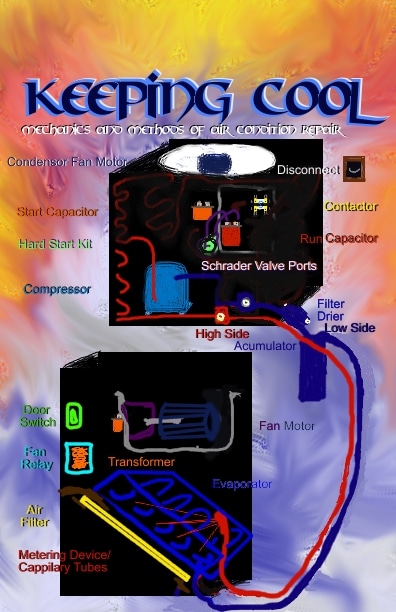The Year is A.C. 101 ~ Welcome to Kung Fu Maintenance Land.
Welcome to my Kung Fu Maintenance A.C. 101 video interactive. You can watch a video discourse on each component of the air conditioner system by clicking on the part or part title in this interactive video menu.
Some of the videos for parts I am still developing and editing. I will add them to the mix as they are completed. Hope you like it. Please do mention it to some friends.
These videos discuss each parts role in the air conditioner system. The thermostat, disconnect, time delay fuses, breaker, contactor, run capacitor, start capacitor, fan motors, compressor, hard start kit, compressor protector (time delay, delay on break, delay on make), filter driers, accumulator, refrigerants, wiring, terminal leads, wire connectors, door switch, fan relay, blower wheel, evaporator coil, restrictive devices (capillary tubes, thx valves etc…), condensor, schrader valves, ports, critical seals, shut offs, thermal switches, directional switches, start, common, run, leads, compressor, hermetic, fans, baffles, gauges, high side (gas, pressure,), low side(liquid, suction), tubing, ACR copper, air handlers, relays, solenoids, air filters, condensate drains, condensate pans, gravel wells, french drains, all working together to take the heat off of you and bring you cold air.
I hope these videos treat you well like a cool glass of lemonade on a blistering hot day. A bit of rejuvenation. So far all of these videos were made on over one hundred degree days. They can’t all be easy, but I’ll settle for a few. I am happy to pass on and share my experiences with you so that your experiences can be a bit easier through understanding. I am out to save you time, money, energy, headache, and backache.
~I hope to hear about or see you gaining some nice ground~
~~Kung Fu Maintenance~~~
~~James H. Klovach~
